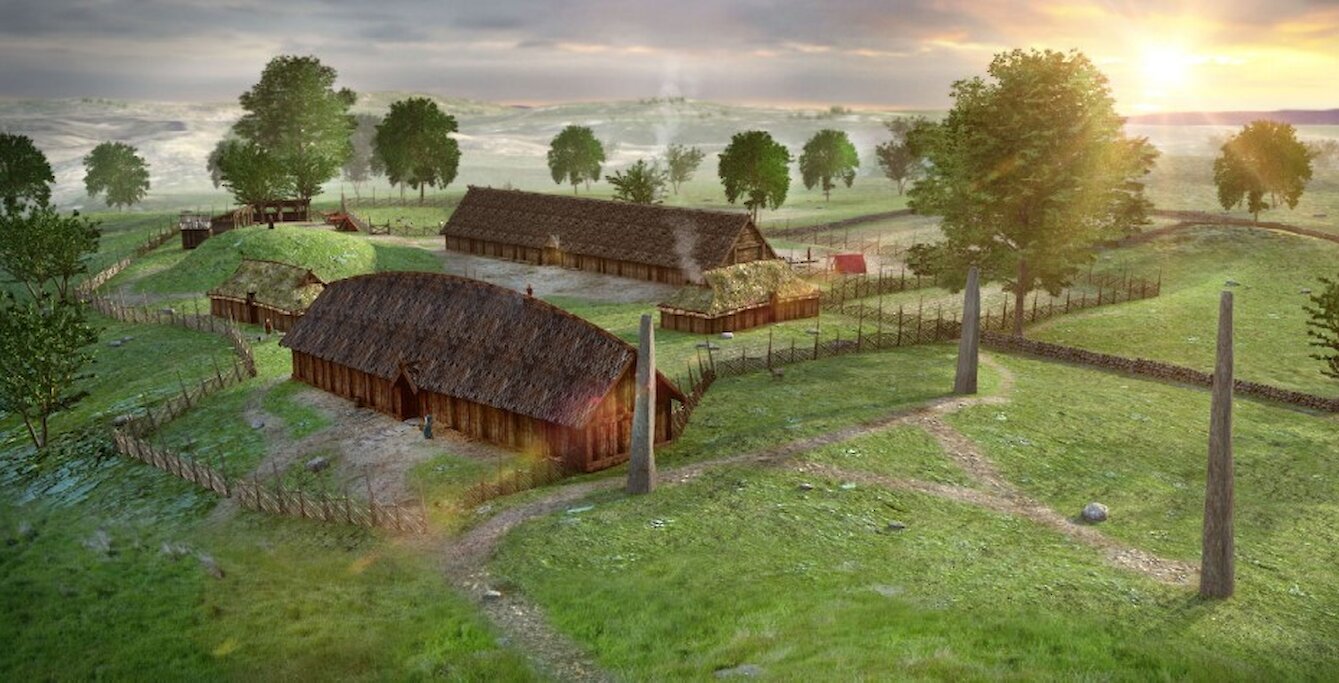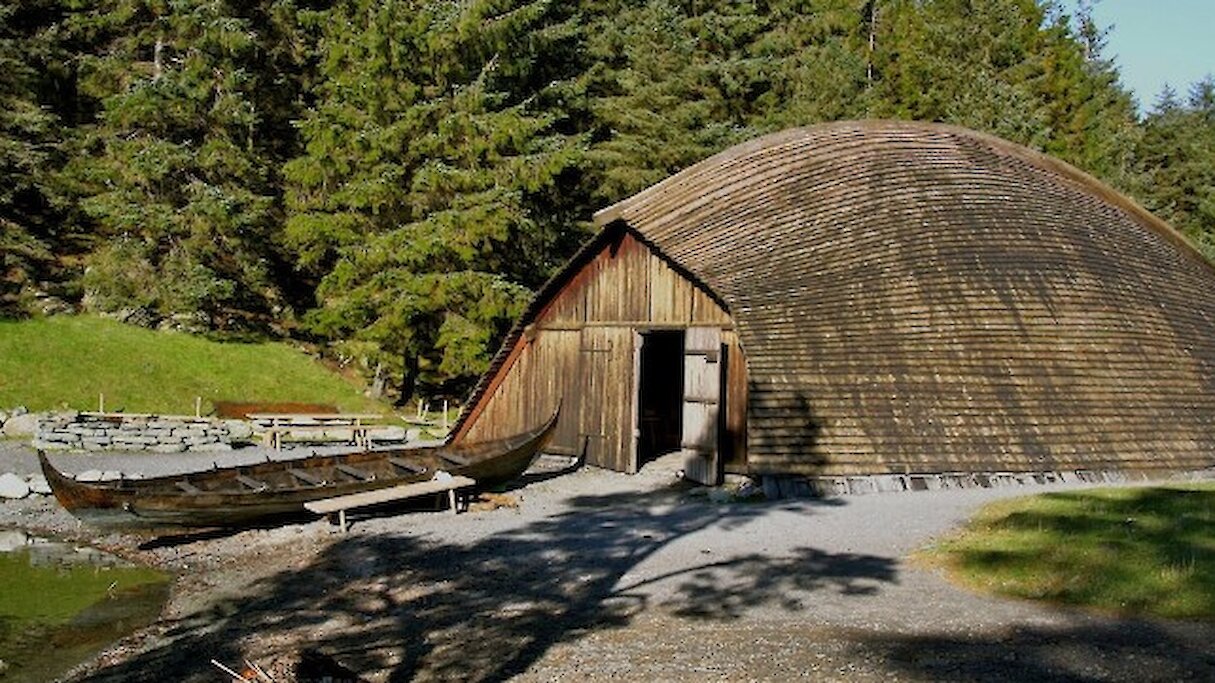Avaldsnes, King Harald 'Finehair's Royal seat' By Geir Sør-Reime
“Most countries have names linked to their territory or ethnic groups, but unlike them, Norway derives its name from the sailing lane along the coast: when people came sailing along the unsheltered stretch from Lista via Jæren northwards, the Karmsund lay as a sheltered sea route towards the north. To the people that lived before us, this was the Norðvegr – the Norway – the Way North.
This strategic location by this important sailing lane made Avaldsnes a centre of power for more than 3000 years. Here, the Avaldsnes princes controlled the coastal traffic up and down the Norwegian coast, and from here, they sent their own ships across the North Sea”.
Avaldsnes was in many ways the outermost border of ‘civilised’ Europe. We know that the princes that had Avaldsnes as their residence adopted Roman habits during the Roman period. The Karmsund is difficult to transverse without motor power due to strong currents and sailing ships had to wait for the currents to turn before they could proceed. At Salhus just north of Avaldsnes, the currents from north and south meet and in practice creates a barrier when the tidal waters collide there. The alternative route along the western coast of the island of Karmøy is very difficult for rowing and sailing boats to cross due to heavy seas and an abundance of small islands and skerries.
This situation created the preconditions for a mighty seat of power at Avaldsnes, especially since the ships were forced to wait for the tide to turn before they could continue through the sound. Many therefore choose to unload their cargo at Avaldsnes, others paid fees/tolls to be able to wait in peace for the tide to turn. In any case, large fortunes were created at Avaldsnes, and that was an important factor when Harald ‘Fairhair’ (born ca. 850 and died AD 931/32), the first king of Norway, choose Avaldsnes as his main residence after his victory over an alliance of Norwegian and Swedish petty kings in Hafrsfjord in AD 872. The reason was simple: Avaldsnes was the centre of Norway.
It was also quite natural for the Hanse League when it wanted to establish trade relations with Norway and its stockfish that they originally choose Avaldsnes as their base and exchanged their goods with stockfish there. Unfortunately (for Avaldsnes), a conflict with the Norwegian king made the Hanse destroy and burn down the Royal Manor at Avaldsnes, and subsequently, they moved their base to Bergen, where they could trade directly with the ships bringing the stockfish from northern Norway.
Burial mounds
The Karmsund still is and has from time immemorial been the gateway to Norway for people arriving from the south, and the gateway to Europe for people coming from the north. The lively traffic through the sound also led to the erection of impressive monuments along the sound, monuments that could be seen by the travellers and remind them of past events. From the Bronze Age to the Viking Age, several majestic burial mounds were erected along the sound, and in addition, the monumental church at Avaldsnes was also placed in close proximity to the sound. In front of the Avaldsnes church, there was a gigantic burial mound called Flagghaugen (the mound with a flagpole) with one of the richest burials from the Roman period in Norway. The so-called Flagghaug Prince was buried together with a wealth of quite unique grave goods.
In fact, the Flagghaug was the site of the first scientific excavation in Norway, excavated between 1834-35 and inside the mound, there was a central burial from around AD 400 with an oak cast, sword, lance, spear, a massive golden arm ring, a silver finger ring, game pieces of glass, a bronze mirror, silver vessels and dishes, silver drinking cups, silver fittings for drinking horns and a bronze wine strainer, a must for wine drinking in those days. The mound also contained two secondary burials with large bronze vessels containing cremated burials.
‘Skrattaskjær
The old Sagas along with the archaeological evidence are the most important sources for our understanding of the Viking Age. The Sagas are Norwegian and Icelandic stories from Medieval times, and they tell stories about kings, families, and the gods.
Just outside of harbour area of Avaldsnes is the skerry ‘Skrattaskjær’, where, according to the Saga of the Norse kings, collected, compiled, and written down by the Icelander Snorri Sturlasson, king Olav Tryggvason, allegedly a grandson of Harald ‘Fairhair’ drowned a group of sorcerers. The Saga says that during Easter AD 997 or 998, a ship full of sorcerers and magicians came to Avaldsnes. They wanted to cast spell on Olav, and conjured up a thick, black mist, but the mist instead of hitting Olav, turned on the sorcerers, who then wandered helplessly around, blinded. Olav caught them and tied them to the skerry at low tide. When the tide came in, the sorcerers drowned. The skerry was then named Skrattaskjær (Sorcerer skerry/rock).
The Royal manor
The ruins of the royal manor were uncovered by archaeologists in 2017. The ruins can now be seen just south of the church. The building of the large hall was started by king Håkon Håkonsson and completed under king Håkon V Magnusson around AD 1300. The manor ruins are
currently being conserved. Avaldsnes is best known as the royal seat of king Harald ‘Fairhair’ and his successors up to the reformation in 1537. But when king Harald choose Avaldsnes as his primary residence, Avaldsnes had already been a royal estate for centuries.
The princes or kings at Avaldsnes are known both from the old sagas and from several rich archaeological finds. All kings we know of before Harald were so-called sea-kings. The first sea-king we know the name of is Augvald and lived during the 7th century. King Harald ‘Fairhair’ also started his career as a sea-king, but during his long reign he also managed to become a land-king. He became the founder of the Norwegian royal dynasty, and subsequent kings always tried to prove their ancestry to him. Avaldsnes is called the oldest royal seat in Norway as king Harald ‘Fairhair’ made it his
main residence after the battle of Hafrsfjord in AD 872. His victory there is still the symbol of the unification of the many petty kingdoms into one unified state, albeit his victory was only the start of the unification process, which was more or less completed by the 13th century.
Final resting place
Based on the description of the Icelandic saga writer Snorri Sturlason in his Sagas of the Norse Kings, Harald’s grave was thought to be in the mound that the millennium monument was erected on top of. Snorri had personally been to the area and to Avaldsnes itself and made detailed descriptions of both places in the Saga of Harald ‘Fairhair’. Even though Snorri has a detailed description of the mound, it is uncertain if the Millennium Monument was erected on what really is the grave of king Harald ‘Fairhair’. Both the size of the mound and in fact also Snorri’s description of the grave itself indicated a Bronze Age mound rather than a Viking Age one. Three mounds on the Karmøy side of the Sound have also been suggested as burial mounds of king Harald, but recent dendrochronological and radiocarbon dating of objects from these seem to indicate that they were erected for princes or kings that lived long before king Harald ‘Fairhair’.
Nonetheless, Harald’s Mound has since 1872 been the concrete manifestation of one of the most important events in Norway, and we are now commemorating the 1150th anniversary of the idea that the whole of the ‘North Way’ should be one, unitary kingdom. The idea for this, king Harald ‘Fairhair’ probably imported from Anglo-Saxon England. All of the ‘civilised’ and gradually Christian Europe adopted the Roman organisation of the Empire into provinces. The introduction of Christianity and the consolidation of Papal power, the Church became a sort of Empire with Church provinces ruled by archbishops. The Church provinces were mirrored by temporal authorities ruled by Kings that guaranteed the safety and status of the Church.
We should also remember that king Harald ‘Fairhair’ sent his youngest son, Håkon, later known as Håkon the Good, to the English royal court to learn how to rule a country, and he returned to Norway as a
converted Christian. Håkon’s attempts of Christianisation of Norway had some initial success, and he won a decisive battle over the sons of his older brother Eirik Bloodaxe (once king of Norway and also the last Viking ruler of Jorvik, England) at Reheia (or Blodheia, Blood Hill) on Karmøu, not far from Avaldsnes, in AD 953. There are many more stories from the Viking age in and around Avaldsnes. A focal point for a visit to the area is the Avaldsnes Nordvegen Histoiresenter.
https://avaldsnes.info/

© Arkikon, Ragnar L. Børsheim

Avaldsnes Nordvegen Historiesenter

Øyvind Aske VisitNorway,com
